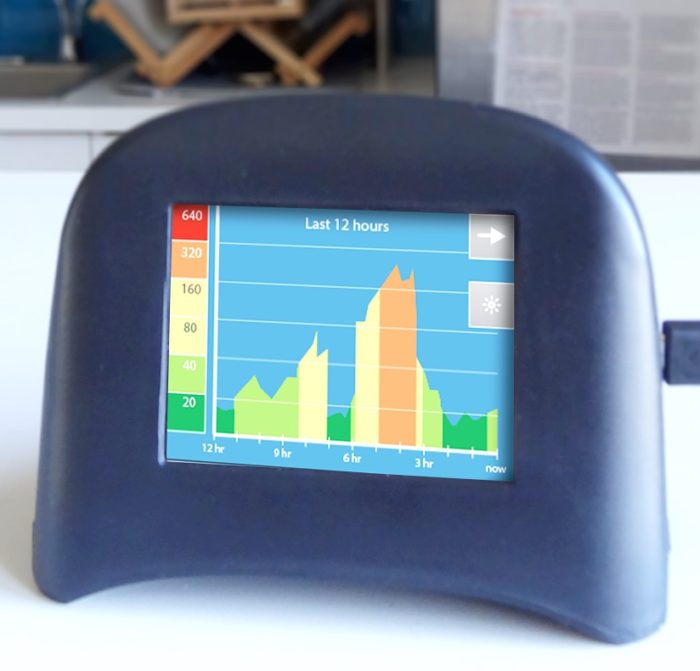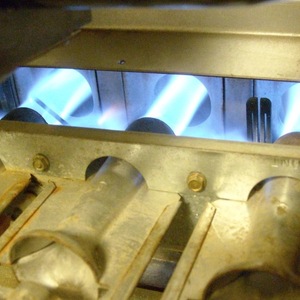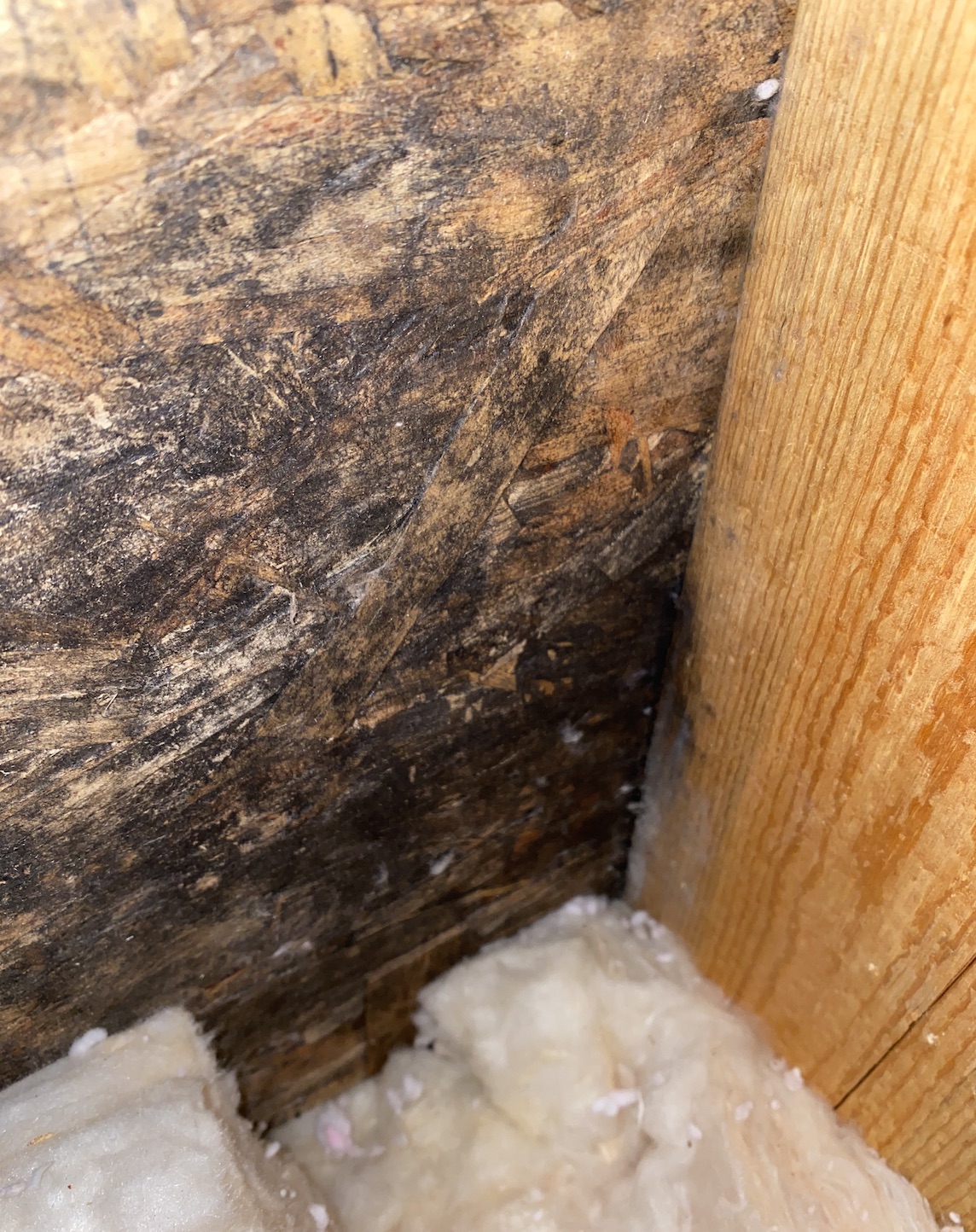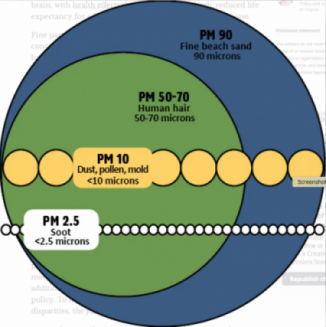Image Credit: Speck
Image Credit: Speck The Netatmo weather station has both indoor and outdoor modules for monitoring temperature, humidity, and C02 levels.
Image Credit: Netatmo The Tzao Enviro-Tracker, which will be available later this year, monitors air quality inside and out and will retail for $99.
Image Credit: Tzao
Consumers soon will have a variety of choices of relatively inexpensive, WiFi enabled devices for monitoring indoor air quality.
One of the devices, called called Speck, was developed at the Carnegie Mellon University Robotics Institute and commercialized by a spinoff company, Airviz Inc. According to an article in AirQuality News, the tabletop device measures levels of fine particulate matter in the air — particles less than 2.5 micrometers in diameter, what the industry calls PM2.5 — and warns homeowners when to close windows or take other steps to reduce pollution levels.
The Speck is WiFi-compatible, allowing homeowners to upload the data to a website that provides analytical tools or share the information with federal monitoring stations. The Speck website says that homeowners can use the data in a variety of ways: to check whether air cleaners are really working, for example, or if a vacuum cleaner is making indoor air unhealthy.
“Sometimes you can see air pollution as a haze in the distance, but in and around your home, it’s invisible,” robotics professor Illah Nourbakhsh told the website. “You might know the PM2.5 level at a government monitoring station miles away, but without a sensor such as Speck, you can’t know what is in the air you breathe and how it might change based on prevailing winds, time of day or what you’re doing.”
The device has a 3.2-inch touch screen. In an e-mail, Nourbakhsh wrote that it has a sensitivity to 0.5-3 microns, allowing it to identify pollutants that are most responsible for asthma, cardiovascular disease, COPD, and other health problems.
The website is taking preorders at $200 (plus postage), and said it would start shipping the device in April.
Blueair measures pollution and cleans the air
A device marketed by a Swedish-based company called Blueair measures air quality and allows homeowners to control an air purifier that removes dust, pollen, and hazardous particles, according to a company description.
Like the Speck, the Blueair is internet-connected. Homeowners can track levels of dust, pollen, and chemicals while they’re in the house or remotely and can turn on an air purifier to clean the air, the company says.
The Blueair Aware, scheduled to be ready for sale by June, is a conically shaped monitor about 8 inches high that will check for PM2.5, like the Speck, as well as volatile organic compounds. The Blueair Aware will sell for about $200.
The device will send air quality information to the owner’s telephone and can be connected to proprietary Blueair air cleaning devices. If indoor air quality declines, the device alerts the air cleaner to start or increase its fan speed, the company says.
Awair indoor sensor to be available this summer
A company called Bitfinder said it would begin to selling Awair this summer. The air-quality monitor is the size of a stereo speaker and will monitor temperature, humidity, levels of dust, carbon dioxide, and volatile organic compounds (VOCs), according to a description posted at Wtvox.com.
Bitfinder has a website but there is essentially no information about the Awair posted there, other than a statement it would be available this summer and a short blog describing the background of the company, which was founded in a garage in Cupertino, California (sound familiar?).
WT VOX quotes company co-founder Ronald Ro as saying that the device will have a variety of uses in commercial as well as residential settings, such as warning homeowners when humidity levels are too low or when the kitchen range is producing unhealthy emissions.
Awair will have a companion smartphone app that produces color-coded alerts and text notifications, rather than a numbers-only approach that most users wouldn’t know how to interpret, Ro told WT VOX.
Netatmo is already on the market
The Netatmo, at $179, is a WiFi-enabled weather station that tracks indoor air temperature, humidity, C02, and even sound levels. The small cylindrical device sends a warning via smartphone when indoor C02 levels reach unhealthy levels.
According to the specifications listed at the website, the Netatmo has a temperature range of 32 degrees to 112 degrees F, humidity of 0 percent to 100 percent, and CO2 from 0 to 5000 parts per million. It apparently does not measure the density of fine or coarse particulates.
The Netatmo also has an outdoor sensor measuring temperature, humidity, and barometric pressure to help users “select the most appropriate transportation and plan your leisure activities.” There’s an optional rain sensor available, and a wind gauge is in the works. Users can display data in graph form to track weather and air quality patterns.
TZOA will sell a portable tracker
San Francisco-based TZOA will be offering a portable air-quality monitor called the Enviro-Tracker that measures temperature, humidity, atmospheric pressure, ambient light, and UV. It will, the website promises, distinguish between PM2.5, fine particulates, and PM10, larger particles that are often allergens.
The device will stream information it collects to a smartphone app, and then to a cloud-based data collection point to create large-scale maps of air quality conditions that anyone could use — sort of like Waze for air.
Users can clip the Enviro-Tracker to their clothing or purse, or leave it at home in its charging cradle to monitor indoor air quality.
The company said it would begin taking orders in May and shipping the device by the end of the year. It will retail for $99.
Weekly Newsletter
Get building science and energy efficiency advice, plus special offers, in your inbox.
















3 Comments
effectiveness and accuracy?
These products seem very appealing, and I am certainly interested in the PM2.5 monitoring capability since my wife has asthma. However, I'm skeptical about low cost sensors. My experience with HVAC products in the professional world is that commodity-priced sensors are often grossly inaccurate, so I am concerned that these products would simply be a waste of money.
Is GBA going to maybe do some testing/reviewing of these devices when they hit the market?
Withings gear
I have a bathroom scale from Withings which also monitors CO2. Withings also makes a camera which contains air quality sensors to measure VOCs. Seems like odd combinations, but they sell 'em!
there is also foobot.io but always-on-wifi make it suck
You might also be interested in a french product, foobot. (formerly alima . It monitors and logs VOCs, CO, CO2, PM, and the cheap obvious Temperature and Relative Humidity.
For me, it would have been the perfect IAQ home monitor, except for one thing.
The flaw with foobot is that it is always transmitting a Wifi signal for monitoring data through a computer, tablet or phone. You simply can't turn it off so, if you want to monitor or log data, you must have wifi radiation inside your home. You get to know the level of air quality at the cost of EM radiation. You also can't connect to foobot through a cable. In my opinion the future trend, specially regarding people that for their IAQ, is to avoid EM radiation indoors as possible.
My conclusion after reading this article is that there is no one complete IAQ logger solution yet, so I'd have to build one from scratch using Arduino and specific sensors.
Suerte
Log in or create an account to post a comment.
Sign up Log in